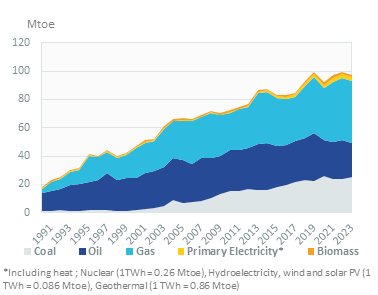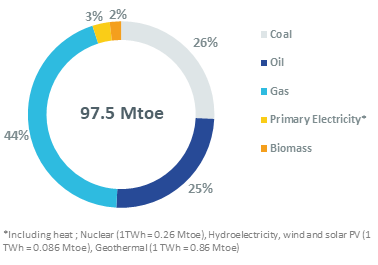-
-
 Energy and Climate Databases
Energy and Climate Databases- The most comprehensive and up-to-date annual energy database.
- Monitoring of technology providers in H2 supply chain.
- Monthly energy data on key energy markets.
- Monitoring of Hydrogen and Derivatives Projects
- The most reliable and up-to-date power generation database.
- The essentials of LNG trade at your fingertips.
- Global monitoring of new and existing refineries.
- Analyse energy consumption and efficiency trends at world level. Benchmark countries.
- Have your database developed by a recognised expert of both energy and IT.
-
 Energy - Climate Forecasts
Energy - Climate Forecasts- Future carbon costs with reliable price forecasts
- Instant access to energy and emissions forecasts.
- Annual projections of wholesale prices up to 2050, based on a 360° approach of the energy markets, enabled by the globally recognised POLES model.
- Wedges module showing a breakdown of the levers enabling to reduce emissions between two scenarios.
- Unique, independent projections of consumption by end-use.
- GHG Marginal Abatement Cost Curves.
- Benefit from proven models to draw your own energy scenarios and anticipate tomorrow’s challenges.
-
 Market Intelligence
Market Intelligence- 110 Energy and climate country reports.
- Tracking trends, EPCs, and national subsidy schemes for residential buildings.
- Daily brief covering the entirety of the turbine industry.
- A newsletter to receive the latest updates on evolving technologies and policies.
- Global energy news and analyses curated daily.
- Enerdata’s experts bring you the essentials about your market and competitors.
-
-
-
 Market Analysis
Market Analysis- Understanding key consumption trends and drivers across sectors.
- Granular and exclusive insight to address the most pressing business and strategic issues.
- Expertise in strategic and business intelligence, with fine-tuning to the market’s specificities.
-
 Energy - Climate Scenarios
Energy - Climate Scenarios- Providing the outlook of an energy commodity in mid to long term time horizons.
- Sector and driver specific energy demand forecasting.
- Assess the evolution of energy prices on the international and regional markets, as well as end-users prices.
- Enerdata guides you through pathways to reach climate targets.
- Supporting local authorities in their decarbonisation strategies.
-
 Climate Strategy and Policy Evaluation
Climate Strategy and Policy Evaluation- Cutting-edge quantitative tools and relevant indicators to monitor and evaluate evolutions on worldwide energy markets.
- Analysis of the most cost-effective options to reduce emissions.
- Quantified simulation and analysis of pledges for climate change negotiations.
- Breakdown of carbon markets and evaluation of the climate change impacts on the carbon price.
- Enerdata guides you on the most beneficial policy or investment options.
- Turning climate objectives into concrete action plans.
-
 Training
Training- Understand different policy targets and measures on energy efficiency.
- How to measure energy savings?
- Energy Forecasting is a 2 days training to learn to design and interpret energy forecasts.
- Energy statistics training allowing to create energy balance with supply, transformation and consumption and understanding the international energy statistics regulations.
- Initiation to EnerMED level 1is the training to approach on the most powerful energy demand forecasting model.
-
-
Resource Centre
Malaysia Key Figures
- Population:
- 35.6 million
- GDP growth rate:
- 5.11 %/year
- Energy independence:
- 96.8%
Data of the last year available: 2024
- Total consumption/GDP:*
- 66.7 (2005=100)
- CO2 Emissions:
- 6.87 tCO2/capita
- Rate of T&D power losses:
- 6.12%
* at purchasing power parity
View all macro and energy indicators in the Malaysia energy report
Malaysia Energy News
View all news, archive your new and create your own daily newsletters only on your topics/countries of interest with Key Energy Intelligence
Malaysia Energy Research
Benefit from up to 2 000 up-to-date data series for 186 countries in Global Energy & CO2 data
A data overview is available in the global energy statistics app
Malaysia Total Energy Production & Consumption
In 2024, consumption per capita was 2.8 toe. This is higher than neighbouring countries. Electricity consumption per capita reached 5 084 kWh in 2024.
Graph: CONSUMPTION TRENDS BY ENERGY SOURCE (Mtoe)

Graph: TOTAL CONSUMPTION MARKET SHARE BY ENERGY (2024, %)

Source: Malaysia energy report
Interactive Chart Malaysia Total Energy Production & Consumption
Source: Global Energy & CO2 data
Benefit from up to 2 000 up-to-date data series for 186 countries in Global Energy & CO2 data
View the detailed fondamentals of the market at country level (graphs, tables, analysis) in the Malaysia energy report
Malaysia Oil Production & Consumption
Oil production has decreased by 2.4%/year since 2010, reaching 24 Mt in 2024. Previously, it remained roughly stable over 2000-2010 at around 33 Mt.
Source: Malaysia energy report
Interactive Chart Malaysia Crude Oil Production & Consumption
Source: Global Energy & CO2 data
Interactive Chart Malaysia Refined Oil Products Production & Consumption
Source: Global Energy & CO2 data
Benefit from up to 2 000 up-to-date data series for 186 countries in Global Energy & CO2 data
Additionally, for more detailed information on refineries, you can request a sample of our Asia Refineries Dataset
Malaysia Natural Gas Production & Consumption
Natural gas production increased by around 4%/year between 2020 and 2024, reaching 80 bcm in 2024, in line with the progression over 2010-2019; it decreased by 10% in 2020 due to the contraction of gas demand induced by the COVID-19 pandemic.
Source: Malaysia energy report
Interactive Chart Malaysia Gas Production & Consumption
Source: Global Energy & CO2 data
Benefit from up to 2 000 up-to-date data series for 186 countries in Global Energy & CO2 data
Additionally, for more detailed information on the LNG trade, you can request a sample of our Asia LNG Trade Dataset
Malaysia Renewable in % Electricity Production
SEDA, the Sustainable Energy Development Authority, was set up in 2011 for checking that sustainable energy programmes are properly managed and for assessing and fostering new sustainable energy solutions.
The 11th Malaysian Plan (2016-2020) goal of reaching 2 GW of renewable capacity in 2020 (large hydro excluded, i.e. >100 MW) was fulfilled as it exceeded 3 GW.
Source: Malaysia energy report
Interactive Chart Malaysia Share of Renewables in Electricity Production (incl hydro)
Source: Global Energy & CO2 data
Benefit from up to 2 000 up-to-date data series for 186 countries in Global Energy & CO2 data
Learn more about renewables in the Mini grid Africa & Asia markets for village electrification
Malaysia GHG emissions and CO2 emissions
In 2021, the country updated its first NDC, pledging to unconditionally reduce its GHG intensity of GDP by 45% in 2030 relative to 2005 (compared to 35% unconditional and 10% conditional, previously).
GHG emissions reached nearly 326 Mt CO2eq in 2021, according to Malaysia's Department of Statistics (LULUCF excluded). In 2019, LULUCF represented a removal of 215 Mt CO2eq, out of total emissions of 330 Mt CO2eq, implying net emissions (i.e. LULUCF included) of 115 Mt CO2eq.
Source: Malaysia energy report
Interactive Chart Malaysia CO2 emissions
Source: Global Energy & CO2 data
Benefit from up to 2 000 up-to-date data series for 186 countries in Global Energy & CO2 data
View the detailed consumption trends at country level (graphs, tables, analysis) in the Malaysia energy report